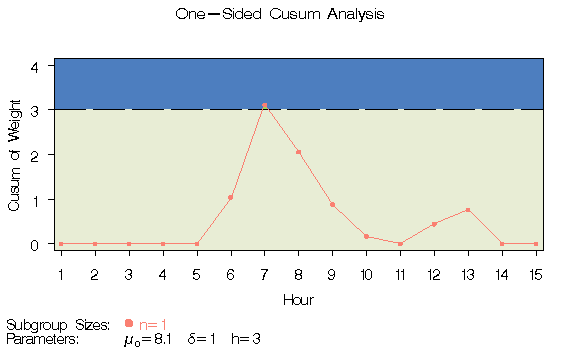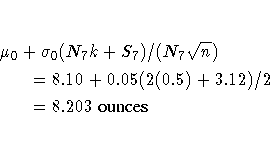Chapter Contents
Previous
Next
|
Chapter Contents |
Previous |
Next |
| XCHART Statement |
| See CUSONES1 in the SAS/QC Sample Library |
An alternative to the V-mask cusum chart is the one-sided cusum chart with a decision interval, which is sometimes referred to as the "computational form of the cusum chart." This example illustrates how you can create a one-sided cusum chart for individual measurements.
A can of oil is selected every hour for fifteen hours. The cans are weighed, and their weights are saved in a SAS data set named CANS:*
data cans;
length comment $16;
label hour = 'Hour';
input hour weight comment $16. ;
datalines;
1 8.024
2 7.971
3 8.125
4 8.123
5 8.068
6 8.177 Pump Adjusted
7 8.229 Pump Adjusted
8 8.072
9 8.066
10 8.089
11 8.058
12 8.147
13 8.141
14 8.047
15 8.125
;
Suppose the problem is to detect a positive shift in the process mean
of one standard deviation (![]() ) from the target of
8.100 ounces. Furthermore, suppose that
) from the target of
8.100 ounces. Furthermore, suppose that
Table 12.18 indicates that these ARLs can be achieved with the decision interval h=3 and the reference value k=0.5. The following statements use these parameters to create the chart and tabulate the cusum scheme:
title "One-Sided Cusum Analysis";
proc cusum data=cans;
xchart weight*hour /
mu0 = 8.100 /* target mean for process */
sigma0 = 0.050 /* known standard deviation */
delta = 1 /* shift to be detected */
h = 3 /* cusum parameter h */
k = 0.5 /* cusum parameter k */
scheme = onesided /* one-sided decision interval */
tableall /* table */
cinfill = ywh
cframe = bigb
cout = salmon
cconnect = salmon
climits = black
coutfill = bilg;
label weight = 'Cusum of Weight';
run;

|
The cusum plotted at HOUR=t is

The option TABLEALL requests the tables shown in
Figure 12.6, Figure 12.7, and Figure 12.8.
The table in Figure 12.6 summarizes the cusum scheme,
and it confirms that an in-control ARL of 117.6 and
an ARL of 6.4 at ![]() are achieved with the
specified h and k.
are achieved with the
specified h and k.
The table in Figure 12.7 tabulates the information displayed in Figure 12.5.
| |||||||||||||||||||||||||||||||||||||||||||||||||||||||||||||||||||||||||||||||||||||||||||||||||||||||
The table in Figure 12.8 presents the computational form of the cusum scheme described by Lucas (1976).
| ||||||||||||||||||||||||||||||||||||||||||||||||||||||||||||||||||||||||||||||||||||||
Following the method of Lucas (1976), the process average at the out-of-control point (HOUR=7) can be estimated as

where S7 =3.12 is the upper sum at HOUR=7, and N7 =2 is the number of successive positive upper sums at HOUR=7.
|
Chapter Contents |
Previous |
Next |
Top |
Copyright © 1999 by SAS Institute Inc., Cary, NC, USA. All rights reserved.